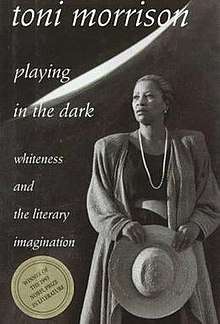Playing in the Dark
 | |
| Author | Toni Morrison |
|---|---|
| Country | United States |
| Language | English |
| Series | The William E. Massey Sr. Lectures in American Studies |
| Subject | Race, American literature, whiteness |
| Genre | Literary criticism |
| Publisher | Harvard University Press |
Publication date | May 1992 |
| Pages | 110 |
| ISBN | 9780674673779 |
| Website | http://www.hup.harvard.edu/catalog.php?isbn=9780674673779 |
Playing in the Dark: Whiteness and the Literary Imagination is a 1992 work of literary criticism by Toni Morrison.
History
In 1990, Morrison delivered a series of three lectures at the Massey Lectures at Harvard University; she then adapted the texts to a 91-page book, Playing in the Dark, published in 1992 by Harvard University Press.[1]
Subject matter
Writing in Signs, Linda Krumholz described Morrison's project as "reread[ing] the American literary canon through an analysis of whiteness to propose the ways that black people were used to establish American identity."[2]
Reviewing Playing in the Dark in The New York Times in 1992, Wendy Steiner said: "The moral and emotional force of [Morrison's] explorations is apparent. If the American identity is formed against this black shadow, it is a sign of abject weakness and a cause for shame....The genius of Ms. Morrison's approach is to enlist those very describers and imaginers—white men of letters—in an investigation that can end only in their self-indictment." But, Steiner added, "it is also not a mere denunciation of white culture. Instead, it is a self-help project meant both to map out new critical territory and to rearrange the territory within."[3]
Michael Eric Dyson observes that in addition to this exploration of the "white literary imagination...Playing in the Dark is also about a black intellectual seizing the interpretive space within a racially ordered hierarchy of cultural criticism. Blacks are usually represented through the lens of white perception rather than the other way around...With [Playing in the Dark], a substantial change is portended."[4]
Reception
In 2016, Time magazine noted that Playing in the Dark was among Morrison's most-assigned texts on U.S. college campuses, together with several of her novels and her 1993 Nobel Prize lecture, making her one of the most-assigned of all female writers.[5]
References
- ↑ Jimoh, A Yemisi (July 2, 2004). "Toni Morrison: Playing in the Dark: Whiteness and the Literary Imagination". The Literary Encyclopedia. The Literary Dictionary Company Limited. Retrieved 8 August 2016.
- ↑ Krumholz, Linda (1 January 1996). "Review of Playing in the Dark: Whiteness and the Literary Imagination". Signs. 22 (1): 243–248. JSTOR 3175058.
- ↑ Steiner, Wendy (5 April 1992). "The Clearest Eye". The New York Times. Retrieved 8 August 2016.
- ↑ Dyson, Michael Eric (1993). Reflecting Black: African-American Cultural Criticism. U of Minnesota Press. p. 181. ISBN 9780816621439. Retrieved 9 August 2016.
- ↑ Johnson, David (February 25, 2016). "These Are the 100 Most-Read Female Writers in College Classes". Time. Retrieved 8 August 2016.
External links
- Playing in the Dark at Harvard University Press